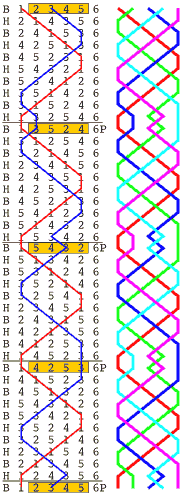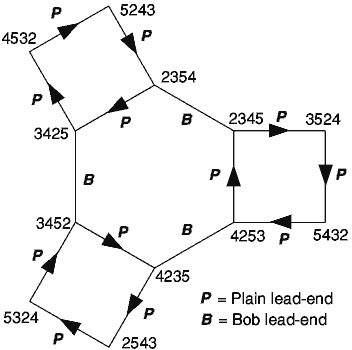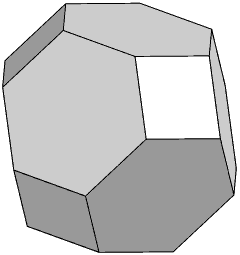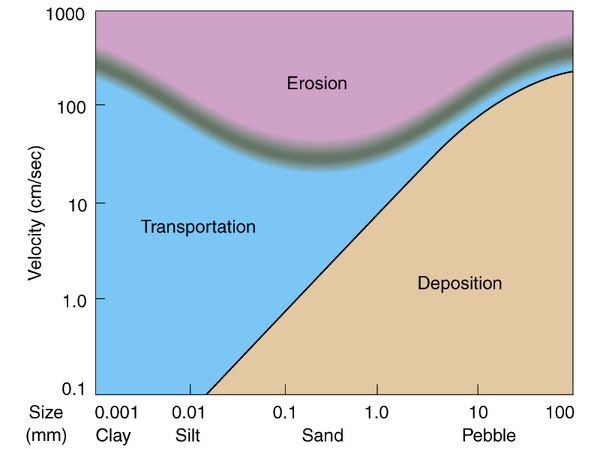
 |
Change Ringing
Change Ringing: The ringing of a set of chimes or bells, especially in a belltower, with every possible unrepeated variation.
This is really interesting. Or at least I think so; I've been doing some reading on this stuff. This is done with bells in church towers for the most part. Change-ringers try to ring bells in different orders, with no bell moving more than one place in succesive rows. And they try to ring all possible orders following that rule. It's hard - with 7 seven bells, there are 5040 permutations and to play them all takes 3 hours or so. People try to compose out peals that solve the problem and some sound really neat when performed. They also exhibit cool mathematical properties. Plain Bob Minimus is a way of ringing 4 bells and you can graph out the placement of one of the bells, here is bell 2 graphed out in Plain Bob Minimus:  Here is Plain Bob Doubles (6 bells) graphed out (the last bell doesn't move):  Pretty cool. You can also graph out where each sequence can go within a certain peal and get these 3 dimensional graphs where each point is a sequence. Here is part of Bob Doubles shown in two dimensions:  But that's only a part, the entire thing makes a Truncated Octahedron like this:  I have a book with an essay about these in it and some of the 2D graphs of compositions using lots of bells look like these snowflake things. People compose new peals and there are societies of people who get together and ring bells. Here is a collection of peal compositions: http://www.ringing.org/main/pages/peals I found that on a site in the UK, where most of this stuff is done. But here is the North American Guild of Change Ringers: http://www.nagcr.org/ Is this not really intersting? I dare you to say it isn't. |
It's also really similar to something that music theorists do. In the 19th century, Hugo Riemann came up with a way of graphing chord relationships and note relationships using transformations and the properties of the tonal system. He called them tonnetz and people make 3D graphs today in a similar way to the change-ringing graphs.
 Look at this shit: http://www-rcf.usc.edu/~echew/papers/CiM2003/ec-cim2003.pdf |
Well, I don't really understand technical music stuff, but I do like looking at graphs and charts, so thanks dude. And I know about geology/gegraphy and all of that stuff.
I also have a top three of graphs, not surprisingly, and this beauty, the Hjulstrom Curve, is my favourite. It relates, with quite stunning beauty, the relationship between water velocity, sediment size and erosion/transportation/deposition.  Your first picture looks like a nice satellite image of a river winding through a semi-developed area. Nice. Sorry to hijack yr thread with some earth science. I just wanted to share the Hjulstrom Curve. |
Quote:
Hey, no problem. Any graph is a cool in my book. :) Hear ye, Hear ye! Post your graphs here! |
I'm given to understand that The Central Council of Bell Ringers are the bastions of traditional peeling.
|
Yes, I got my link to the collection of peals from them.
|
Strangely enough I was sorting out my room the other day and found my deceased grandads book of peals... he was quite a keen ringer, it seems. I may get involved sometime soon, it seems like a nice thing to do of a weekend.
*Edit - no dead ringer jokes please. |
very interesting thread I didn't know so much existed about ringing
|
The bells here ring the same thing all the time. It sounds like a doorbell.
|
| All times are GMT -5. The time now is 10:16 PM. |
Powered by vBulletin Version 3.5.4
Copyright ©2000 - 2025, Jelsoft Enterprises Ltd.
All content ©2006 Sonic Youth